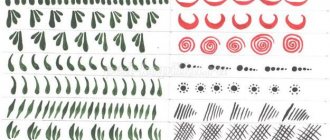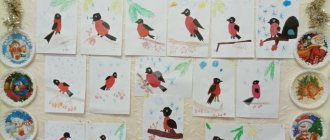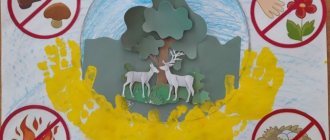Summary of a lesson on learning to play chess for preschool children 4-5 years old.
author: Victoria Petrovna Barmatova
teacher-psychologist, MDOU “Kindergarten “Buratino”, Nadym”
Summary of a lesson on learning to play chess for preschool children 4-5 years old.
"Chess Kingdom"
Subject
:
"Start position"
Target
:
Introduce children to new concepts: “initial position or starting position”, remember the rule “the queen loves her color.”
Teach correctly, place the board between partners. Reinforce new material through didactic games and tasks. Tasks:
Educational
: to form an idea of the chess game, chess pieces;
Developmental
: develop children’s sensory skills, analytical and visual perception;
Educational
: cultivate a positive attitude towards the results of one’s activities, the ability to cooperate, and provide assistance to one’s peers.
Progress of the lesson
:
Teacher-psychologist: - Hello, guys. My name is Victoria Petrovna, I came to visit you and I have a very interesting game in my hands (hands behind my back, so that the children do not see behind you). And to make it easier for you to guess the game that is behind me, I will ask you riddles.
Children: good.
P: -The whole board is in squares,
They are full of soldiers.
The soldiers have no ammunition,
But they will put checkmate.
D: - Chess.
P: - That's right, guys. (showing the children a chessboard with a bi-ba-bo toy)
P: - Let us now place the pieces on the board. As you can already see, the entire board consists of squares. What color are they?
D: - black and white.
P: - absolutely right, and also, guys, the cells can be not only black but any other dark color, and light ones can also differ in color from white, and this will not be a violation in the game. How many of you already know this game?
D: - I, I, I.
P: – now let’s open the chessboard and arrange the chess pieces. (But instead of chess, children see a toy)
D: - who else is this?
Chess King: - I, the White Chess King, where is my army? You do not know?
D: - No, we don’t know.
Shk: - probably it was the old witch who kidnapped my retinue while I was sleeping, and I was left alone. Help me guys, how can I get my warriors back? They will be lost without me, without them I am no longer the Chess King, but just a toy. After all, guys, you probably wanted to play chess, but without a king, there can never be a game!!!
P: - Guys, let's help the Chess King find his retinue?
D: - Yes!!!
P: - But how can we do this? (addressing the king)
Shk: - When I woke up, I only had this piece of paper in my hands, something was written on it.
P: Guys, these are riddles. And we, dear Chess King, really love solving riddles. Really guys?
D: - Yes!!!
P: – Listen carefully, the one who knows the answer raises his hand.
P: - Vasya jumped and galloped,
And, of course, tired.
So that Vasya can rest
He needs to sit down on ... (chair). The one who guessed right looks for chess pieces on the chair.
D: - children's answer
P: - That's right, a chair. Let's look for a chair on which there may be a squad of warriors of the white chess king.
The children find the rest of the chess pieces on the chair, previously hidden in the bag.
Shk: - Yes, this is my retinue, thank you, dear children. I am very glad that you have such wonderful, kind and attentive helpers in your garden.
Addressing his soldiers, Shk commands each piece on the board to take its place.
P: - Guys, now we will see how the placement of chess pieces on the board begins. You already know that there is a dark and a light square, and there are also numbers and letters on the board. But, since you don’t know these letters yet, but only the numbers, you need to place the board so that the numbers are located along the edges of the board, and the letters are below. And if you look at the cells, the first cell to your left will always be dark in color, and the first cell to your right will always be light. So you learned how to properly set up a chessboard for the game.
Shk: - and now it’s time for my army to take the initial position
.
There are tall figures on the first line, and my soldiers line up on the second line. The first chess piece to appear on the board is the queen
.
Remember guys, the queen loves her colors
.
If he is white, then his cage is also white. chess king
will stand nearby
chess bishops
will stand on the edges of me and the queen , then
the chess knight
, and from the very edge our venerable
rook.
In front of this row are our soldiers -
chess pawns
.
Now we are ready for battle. This guys is called the starting position
in the game.
P: - guys, look how the chess pieces all took their places in unison, everyone has their own specific place in this starting position
. And every piece, from pawn to queen, will fight on the field to defend the honor of the king. But we will find out how they do it next time. How many of you guys have a Chess game at home? Ask your parents to help you place the chess pieces on the board, and do not forget about the correct location of the chess board between partners. Goodbye, see you again.
D: - Goodbye.
MUNICIPAL PRESCHOOL EDUCATIONAL INSTITUTION "KINDERGARTEN "BURATINO" OF NADYM"
___________________________________________________________________
Summary of a lesson on learning to play chess
for preschool children 4-5 years old.
Prepared by:
educational psychologist
Barmatova V.P.
Summary of a lesson on learning to play chess for preschool children 4-5 years old.
LiveInternetLiveInternet
Chess is a game that develops a child’s analytical abilities, spatial thinking and decision-making skills. Even small children easily learn to play chess, remember the rules and play with pleasure. The most difficult thing in teaching a child to play chess is getting started.
Chess is a game that requires the ability to visualize and navigate the game board. To help a little chess player better remember what a chessboard looks like, you can use various developmental exercises. For example, ask him to draw - on a white sheet of paper or with chalk on the asphalt - a fragment of a chessboard. Or put together a fragment of a chessboard from cubes of two colors. Or take a sheet of lined paper and ask your child to color the squares in a checkerboard pattern. While walking or visiting, pay attention to objects that have a “chess” pattern. Ask your child to remember where, besides the chessboard, he saw the same pattern. In all exercises, pay attention to the alternation of light and dark fields and prompt your child if he has made a mistake.
Horizontals and verticals This is what Pawn told Slava about Chess Country. On a chessboard, white and black cells always alternate. Paths formed from cells are called lines. Lines are vertical and horizontal. Place your finger on any square near the left edge of the board. Now slide your finger across all the cells from left to right - it has “walked” along a path of eight cells. This is a horizontal line.
There are only eight horizontal lines. Run your finger over each one. Look at the picture on the previous page so as not to be mistaken. The same paths lead from you towards the enemy. They are called vertical lines. There are eight verticals, as well as horizontals. Run your finger along each vertical line. There is a picture at the top of this page in case you get confused. To point to a cell, do not point your finger at it: this is impolite. In addition, when there are pieces on the board, they can be accidentally touched. You just need to say at the intersection of which vertical and horizontal lines the desired cell is located.
Each square on the chessboard has its own address so that it cannot be confused with others. The address consists of the name of the vertical and horizontal lines that intersect on this cell. The verticals are called letters of the Latin alphabet: a, b, c, d, e, f, g, h. If you play with white, then square a is to your left. The horizontal lines are designated by numbers from 1 to 8. Then, when there are pieces on the board, you will see that number 1 is on the horizontal line on which the white king and queen stand, and number 8 is on the horizontal line on which the black king and queen stand. Look at the map on the next page: the names of the cells are now visible on it. Look at which square the white king is on. This is a vertical with the letter e and a horizontal with the number 1. This means that we must say: “The king stands on square el.” — So, I need to get to square el? - Slava asked when Pawn finished telling. - Exactly. There you will find the royal palace, and in it the White King. - How do I recognize him? “I’m sure you’ll guess right away.” Of course, horizontals and verticals are the most important lines in the chess kingdom. But you need to know not only about them. There are other lines too. Do you see how cells of the same color touch at the corners? Straight chains of such cells form diagonals. Diagonals are not like other lines. In each diagonal, all cells are the same color.
Another difference is that all horizontal and vertical lines are the same length, while the diagonals are different. Run your finger along all the diagonals and count them. Which diagonals are the longest? Which ones are the shortest? The large white diagonal and the large black diagonal have eight fields each. Where they intersect is the center of the chessboard. This is a square of four cells - two white and two black. Having said goodbye to Pawn, Slava went to look for the royal palace. The boy walked for quite a long time through white and black fields, but finally reached a large building. Approaching the huge doors of the palace, Slava heard someone inside loudly indignant: “It’s a disgrace!” Where can I find the general?! Why can't anyone in the kingdom find me a general?! It's outrageous! An important battle is coming soon, and there is no one to command the army! Slava carefully opened the door and looked inside. He saw a large hall with columns. In the middle of the hall there was a pedestal on which stood a throne, like in cartoons. On the throne sat a small man wearing a robe and crown. The Pawns stood in front of him - they all behaved very quietly and every now and then they bowed respectfully so that their berets almost fell to the floor.
The man on the throne was making the same screams that Slava had heard outside. The door creaked, and everyone immediately turned and stared at Slava. The boy was embarrassed and blushed. - Who are you and what are you doing here? - asked the man on the throne. - My name is Slava, hello. And you are probably the White King? - How did you guess? “You sit on the throne and shout at everyone else.” In fairy tales this is what kings usually do. - I know who you are! — the White King immediately declared. With these words, he jumped from the throne and quickly ran up to Slava. - You are my new general! Let's go see your troops! “You were mistaken, Your Majesty,” Slava answered politely (from cartoons he remembered how to address kings). - I'm not a general at all. Only adults and wearing caps are generals. “Nonsense,” the King snapped. - It's not about the cap. And if you want, I will find a cap for you. So, will you be my general or not?
- Why do you need a general? - To command my army, of course. After all, the battle is coming - someone must fight on my side! I have soldiers, all I need is a general. - What, your soldiers don’t know how to fight themselves? - Slava was surprised. - How can they! — the King was offended. - The best! But there must be discipline in everything. They are brought up this way: they will not go anywhere without an order, so that there is no confusion. Everything needs order! “Can’t you give orders yourself?” - Slava asked then.
https://isoveti.ru/dlya-mam/znakomstvo-rebenka-s-shaxmatnoj-doskoj.html
Chamomile 2012
Lesson summary “Introduction to the chessboard”
Lesson notes using an interactive whiteboard
"Introducing the Chessboard"
Introducing the chessboard.
Target
: introducing children to the chessboard
and
its features
.
Training tasks:
Strengthen the ability to compare by shape and location in space.
Developmental tasks:
Create conditions for the development of logical thinking, intelligence, and attention.
Contribute to the formation of mental operations, speech development, and the ability to give reasons for one’s statements.
Educational tasks:
Develop independence, the ability to understand a learning task and complete it independently.
Equipment:
presentation for the lesson, multimedia installation, interactive whiteboard, demonstration chessboard.
Progress of the lesson.
Children enter the group.
Educator: Guys, today I want to tell you one amazing story. Make yourself comfortable.
Slide No. 1 is on the board screen.
Educator: We will learn about the amazing adventures of the chessboard
Slide No. 2
And
Educator: People lived freely on Earth in ancient times. They breathed clean, invigorating air, drank clear spring water, and hunted wild animals in the dense, majestic forests. And their children deeply inhaled the life-giving aroma of meadow herbs and flowers. But the guys didn’t have any interesting games.
Slide number 3.
Educator: One day the bravest guys Lena and Alen went to the Sorcerer and asked: “Where can we find an extraordinary game?” The Sorcerer grinned: “If you cross the Deep Forest, swim along the Stormy River and go through the Burning Fire, such a game will be next to you... But beware of the sorcerer.” Lena and Alen thanked the Sorcerer and set off. They really wanted to get the coveted game.
Slide number 4.
Educator: The guys were in a hurry and did not notice that one old man was following them. He watched the children predatorily and, grinning, patted his sides, where the empty bag dangled and the sharp sword rested in its sheath. Lena and Alen entered the Dense Forest, and the age-old trees swayed, rustling their leaves: “Opa... Oopa... Opa...”. They wanted to suggest that danger awaits children. But the guys did not pay attention to the whispering of the trees.
Slide number 5.
Educator: Lena and Alen went out into the clearing. (an image of a sorcerer is displayed on the screen)
Educator: and they came face to face with the old men. He laughed evilly: - Yeah, we got caught! Don't know me? I am the sorcerer Zvol (the image of the bag is displayed)
Educator: And this is my bag. I’ll put you in it and take you to my place. You will serve me. And Zvol tried to throw the bag over the guys, but missed. But Alain was not at a loss, tripped the sorcerer’s leg, and the old man fell. Alen and Lena took off running.
Slide number 6.
Educator: The sorcerer sees that he cannot catch up with the fugitives, he pulled out a sword and chopped at a tall tree. I sawed it through like a saw. Zvol aimed the tree at the guys, but didn’t hit. Only the branches whipped across the cheeks of Lena and Alain. Out of frustration, the sorcerer grabbed the stump with his sword and cut off a round piece of wood, large and smooth. Zvol grabbed the round timber and threw it forcefully at the fugitives (an image of the round timber is displayed on the slide).
Educator: Alen liked the round timber. He picked it up, stuck his tongue out at the sorcerer, and rushed on with Lena. They ran away from Zvol.
Slide number 7.
Educator: Here is the Forest behind. In front of the guys is the Stormy River. Let's lower your piece of wood into the water - it will be a raft, Lena suggested. Suddenly, out of nowhere, a sorcerer appeared in front of the guys. He stands there, stroking his sword mockingly. Zvol waved his sword over Alen; the boy barely managed to cover himself with the round timber as if it were a shield. The sorcerer raised and lowered the sword three more times, but he could not even scratch Alen. Only the shield changed from round to square. Then the sorcerer pushed Alena, threw Lena over his shoulder and trotted away. Alain was not taken aback and deftly threw his shield after the villain. Knocked the sorcerer's shield off his feet.
Slide number 8.
Educator: Guys, how do you think Lena and Alen can get across the raging river? (children's answers).
- That's right, they can swim across on their shield (demonstrates how children can swim across the river on a shield).
Slide number 9.
Educator: Zvol appeared on the other bank with a bow in his hands and, one after another, sent arrows at the fugitives. But the raft turned into a shield again and saved the children.
Slide number 10.
Educator: . Out of anger, the sorcerer broke his bow and wandered away. Lena and Alen pulled out the arrows from the shield and noticed that it had become lined with cells.
Slide number 11.
Educator: Ahead, the Burning Fire stands like a wall. Alen took Lena by the hand, put his shield forward, and they quickly, quickly ran through the Fire. The flames attacked the shield with fury, but Lena and Alen remained safe and sound.
Slide number 12.
Educator: The flames attacked the shield with fury, but Lena and Alen remained safe and sound. They made their way through the raging flames and were amazed: Burning Fire turned out to be a naughty person - every second cell on the shield turned black. (an image of a sorcerer is displayed).
Educator: Suddenly, Zvol jumped out of the Fire with a howl with a bag on his shoulder. The Burning Fire pinched his heels, but it didn’t help the boys - with a victorious cry, the sorcerer pulled the bag over them. (the image of the children is covered by the image of the bag)
Educator: But he was happy early. The bottom of the bag burned out, and the guys got out of it and ran away.
Slide number 13.
Educator: I'm tired of this evil guy! – Lena cried out in her hearts. - How to get rid of him? (image of a sorcerer).
Educator: The face of the Sorcerer appeared in the sky: - The power of the sorcerer is in his name... Decipher it, and the Evil One will lose its power. Alen took chalk out of his pocket and wrote in the squares of the shield: “ZVOL.” (the word Zvol is placed on the board)
Educator: Guys, help Alen and Lena decipher the word “Evil.” (children’s answers)
– “3” is probably “evil”? – Lena suggested. – What is “VOL”? - Shut up, shut up! – the villain babbled in fear. - Hooray! We're right! – Alain was delighted. – He is an evil sorcerer... But then his name would be ZKOL, not EVIL?! - I know I know! – Lena screamed. – ZVOL is the Evil Wizard! This is his secret! The sorcerer crouched, became decrepit and wandered away dejectedly, like a beaten dog. – We have come a difficult way. Even the sorcerer was defeated. Where is the treasured game? – Alain asked sadly. “It’s in your hands,” the Sorcerer smiled. – You are holding a CHESS BOARD in your hands. This is the site of the most exciting game in the world, whose name is CHESS!
Slide number 14.
Educator: But these are the types of chessboards.
Then a demonstration chessboard is set up.
Educator: This is a chessboard, chess battles take place on it. It is all neatly lined up into equal dark and light squares, which are called fields in chess. Light cells are white fields. Dark cells are black fields. Black and white fields always alternate: white-black-white-black.
Educator: In which fields does nothing grow? (children's answers)
What kind of boards can you use to build nothing? (children's answers)
In which cages are animals not kept? (children’s answers)






